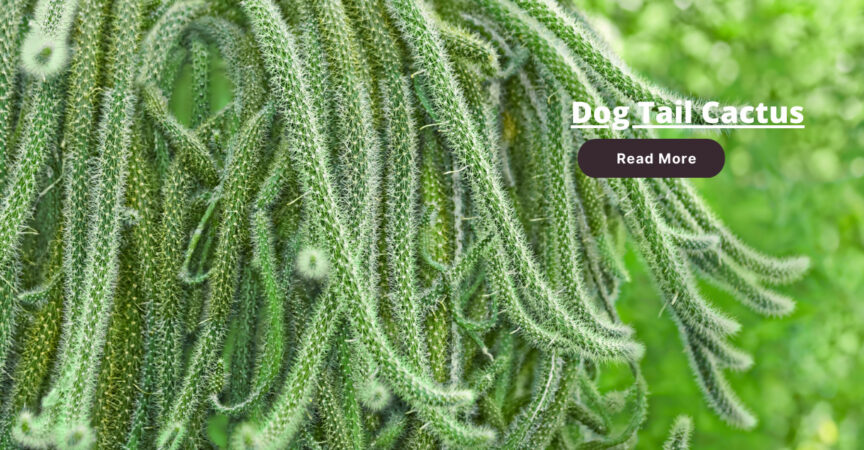Dog Tail Cactus: Care, Propagation, Plant ⏬👇
The Dog Tail Cactus, scientifically known as Cleistocactus winteri, is a distinctive and eye-catching member of the cactus family. Its long, trailing stems and vibrant red flowers make it a fascinating choice for both experienced cactus enthusiasts and those new to succulent gardening.
Dog Tail Cactus Care
Dog Tail Cactus, scientifically known as Cleistocactus winteri, is a unique and eye-catching cactus species. Here’s a brief guide on how to care for this intriguing plant:
1. Sunlight:
- Dog Tail Cactus thrives in bright, indirect sunlight. Place it near a window with plenty of filtered sunlight, especially during the morning hours.
2. Temperature:
- Maintain a warm environment for your cactus. It prefers temperatures between 70-100°F (21-38°C) during the growing season but can tolerate cooler conditions in winter if kept dry.
3. Pot and Soil:
- Plant your Dog Tail Cactus in well-draining cactus or succulent soil. A pot with drainage holes is essential to prevent waterlogged roots.
4. Watering:
- Allow the soil to dry out between watering. Water sparingly during the growing season (spring and summer) and reduce watering in the dormant winter months.
5. Humidity:
- Dog Tail Cactus is accustomed to low humidity levels, making it suitable for indoor environments.
6. Fertilizing:
- Feed your cactus with a diluted, balanced, liquid cactus fertilizer during the growing season, typically every 4-6 weeks.
7. Pruning:
- Prune your Dog Tail Cactus as needed to remove dead or damaged stems. Wear gloves as the tiny glochids (spines) can be irritating to the skin.
8. Repotting:
- Repot your cactus every 2-3 years, or when it outgrows its current container. Select a slightly larger pot with good drainage.
9. Pests and Diseases:
- Dog Tail Cactus is generally resistant to pests and diseases. However, watch out for common cactus pests like mealybugs and scale. Treat infestations promptly.
10. Caution:
- Handle your Dog Tail Cactus carefully, as its tiny spines (glochids) can be painful if they get embedded in the skin. Wear gloves when repotting or pruning.
Dog Tail Cactus is a striking addition to any succulent collection and requires minimal care. By following these guidelines, you can enjoy its unique beauty while keeping it healthy and thriving.
Dog Tail Cactus Propagation
Propagation is a wonderful way to expand your Dog Tail Cactus collection or share this unique plant with friends. Here’s a concise guide on how to propagate Dog Tail Cactus:
Propagation Methods:
- Seeds:
- Collect seeds from mature Dog Tail Cactus by allowing the flowers to produce fruit and naturally dry on the plant.
- Sow the seeds in well-draining cactus or succulent soil in a shallow container.
- Keep the soil consistently moist but not waterlogged.
- Germination usually takes a few weeks to several months.
- Offsets:
- Dog Tail Cactus occasionally produces offsets, also known as pups or baby plants, around its base.
- Wait until the offsets are a reasonable size, typically a few inches tall, before attempting to separate them.
- Gently remove the offset from the parent plant, taking care not to damage the roots.
- Allow the offset to air dry for a day or two to form a callus, which reduces the risk of rot.
- Plant the callused offset in a new pot with well-draining soil.
Propagation Tips:
- Timing: Propagation is best done during the growing season in spring or early summer when the plant is actively growing.
- Soil: Use a well-draining succulent or cactus mix for both seed sowing and offset planting.
- Containers: Shallow containers or seed trays work well for seeds, while small pots are suitable for offsets.
- Light: Provide bright, indirect light for newly propagated plants to avoid sunburn.
- Water: Water sparingly until new growth is evident to prevent rot. Gradually transition to the standard watering routine.
Patience is Key: Dog Tail Cactus propagation requires patience, as both seeds and offsets take time to grow into mature, striking plants. With the right care and attention, you can enjoy the beauty of these cacti in your collection or garden.
Dog Tail Cactus Succulent
Dog Tail Cactus, scientifically known as Cleistocactus winteri, is a captivating succulent that’s sure to add a unique touch to your plant collection. Here’s a brief overview of this remarkable succulent:
Appearance:
- Dog Tail Cactus features long, slender stems covered in fine, white spines, giving it a distinct appearance reminiscent of a dog’s tail.
- The stems can grow to be several feet long, creating a striking hanging or trailing effect.
- During the blooming season, it produces vibrant red or orange tubular flowers that contrast beautifully with its green stems.
Care Tips:
- Light: Dog Tail Cactus thrives in bright, indirect sunlight. It can handle some direct morning sunlight but should be protected from harsh afternoon sun.
- Temperature: Maintain a warm environment, as it prefers temperatures between 70°F to 100°F (21°C to 38°C) during the growing season and should be protected from frost.
- Watering: Allow the soil to dry out completely between waterings. Water sparingly, especially during the winter months.
- Soil: Use a well-draining cactus or succulent mix to ensure proper drainage.
- Fertilization: Feed with a balanced, diluted cactus fertilizer during the growing season (spring and summer) about once a month.
Propagation:
- Dog Tail Cactus can be propagated from offsets (baby plants that grow at the base of the mature plant) or from seeds.
- Separated offsets can be planted in their pots once they’ve developed roots or callused.
- Seeds can be sown in well-draining soil, and germination typically takes a few weeks to months.
Unique Feature:
- One of the most intriguing features of Dog Tail Cactus is its cascading growth habit, making it an excellent choice for hanging baskets or as a trailing accent in succulent arrangements.
- Its fiery-colored flowers are another highlight, adding a splash of color to your indoor or outdoor space.
Caution: Like many cacti, Dog Tail Cactus has spines that can cause skin irritation, so handle with care.
Add this distinctive succulent to your collection to enjoy its charming appearance and relatively low-maintenance care requirements.
Dog Tail Cactus Plant
The Dog Tail Cactus, scientifically known as Cleistocactus winteri, is a striking succulent that has gained popularity among plant enthusiasts. Here’s a concise overview of this intriguing plant:
Appearance:
- The Dog Tail Cactus is characterized by its long, slender stems covered in fine, white spines, resembling a dog’s tail, which gives it its common name.
- These stems can grow to impressive lengths, often trailing or hanging gracefully.
- During the flowering season, it produces vibrant red or orange tubular flowers, creating a stunning contrast with its green stems.
Care Guidelines:
- Light: Dog Tail Cactus thrives in bright, indirect sunlight. While it can tolerate some direct morning sunlight, protection from intense afternoon sun is essential.
- Temperature: Maintain a warm environment, with temperatures ranging between 70°F to 100°F (21°C to 38°C) during the growing season. Protect it from frost and cold drafts.
- Watering: Allow the soil to completely dry out between watering sessions. Water sparingly, especially in the winter months when it goes through a rest period.
- Soil: Ensure it’s planted in a well-draining cactus or succulent mix to prevent waterlogged roots.
- Fertilization: Feed the Dog Tail Cactus with a diluted, balanced cactus fertilizer during the active growing season (typically spring and summer) approximately once a month.
Propagation:
- You can propagate Dog Tail Cactus through offsets, which are small shoots that grow at the base of the main plant, or from seeds.
- When offsets have developed roots or callused, they can be planted in individual pots.
- Seeds can be sown in well-draining soil, and germination usually takes a few weeks to months.
Unique Feature:
- What sets the Dog Tail Cactus apart is its trailing growth habit, making it an excellent choice for hanging baskets or as a decorative trailing element in succulent arrangements.
- The vividly colored flowers it produces during the blooming season are a delightful addition to your indoor or outdoor space.
Note: Like many cacti, the Dog Tail Cactus has spines that can cause skin irritation, so be cautious when handling it.
With its captivating appearance and relatively undemanding care requirements, the Dog Tail Cactus is a fantastic addition to any succulent collection.
Dog Tail Cactus Tips
The Dog Tail Cactus, scientifically known as Cleistocactus winteri, is a unique and visually striking succulent that’s relatively easy to care for. Here are some essential care tips to ensure your Dog Tail Cactus thrives:
1. Light:
- Dog Tail Cacti love bright, indirect sunlight. They can tolerate some morning sun, but avoid intense afternoon rays, which can scorch the plant.
2. Temperature:
- Maintain a warm environment. These cacti prefer temperatures between 70°F to 100°F (21°C to 38°C) during their active growing season.
- Protect them from cold drafts and frost, as they are sensitive to low temperatures.
3. Watering:
- Allow the soil to completely dry out between watering sessions. Overwatering is a common mistake with cacti.
- In the growing season (typically spring and summer), water sparingly. During the dormant winter period, reduce watering significantly.
4. Soil:
- Plant your Dog Tail Cactus in well-draining cactus or succulent soil mix. Good drainage is crucial to prevent root rot.
5. Pot Selection:
- Use a pot with drainage holes to help excess water escape. This prevents waterlogged soil.
6. Fertilization:
- Feed your cactus with a diluted, balanced cactus fertilizer during the growing season, approximately once a month.
- Avoid over-fertilizing, as this can harm the plant.
7. Pruning:
- Prune dead or damaged stems to encourage healthy growth and maintain its attractive appearance.
8. Propagation:
- Dog Tail Cacti can be propagated through offsets (small shoots that grow at the base of the main plant) or seeds.
- Offsets can be separated and planted in their pots when they have developed roots or callused.
- Seeds can be sown in well-draining soil and require patience as germination may take several weeks to months.
9. Handling with Care:
- Be cautious when handling your Dog Tail Cactus as it has spines that can cause skin irritation. Using gloves is advisable.
10. Pests and Diseases: – Keep an eye out for common succulent pests like mealybugs and spider mites. – Ensure good air circulation to prevent fungal diseases.
Incorporate these tips into your Dog Tail Cactus care routine, and you’ll enjoy a healthy, vibrant succulent that adds a unique touch to your indoor or outdoor space.
Email Bülteni
Yeni yazılarımızdan hemen haberdar olmak için kayıt olun.







